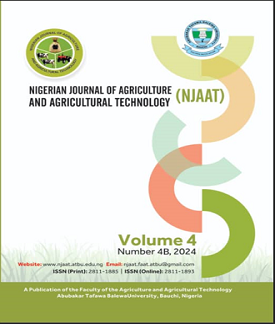IMPACT OF FINANCIAL DEVELOPMENT AND CASH CROP EXPORT GROWTH IN NIGERIA: IMPLICATIONS FOR THE EMERGING EXPORT 35 REDEFINED POLICY
DOI:
https://doi.org/10.59331/njaat.v4i4B.907Keywords:
Export, Compound, Annual growth, Development, Finance-led hypothesis, Long-runAbstract
The study evaluates the impact of financial development on agricultural export growth in Nigeria: implications for the emerging export 35 redefined policy. From the Central Bank of Nigeria and Food and Agriculture Organisation databases, time series data were obtained between 1988 and 2022. The compound annual growth model, Johansen-Juselius cointegration test, and long-run estimation techniques were applied to the data with the aid of EViews statistical package. Findings on growth rate showed that while CLG export had the highest growth rate (14.69%), LCFG decelerated by 10.99%; LCBLA accelerated by 24.57% while PLR recorded a decline of -0.83%; LCLG in monetary terms had the highest growth rate of 31.74%. Furthermore, financial development indicators significantly exhibited asymmetric effect on the exportation of cash crops in the long-run. It was recommended that the Federal Ministry of Agriculture and Food Security, Nigerian Export Promotion Council, the Central Bank of Nigeria and Boards of Commercial Banks should collaborate to improve agricultural financing and secure a favourble exchange rate policy for cash crop exportation to increase the growth of the agricultural sector for sustainable economic growth.
Downloads
Downloads
Published
How to Cite
Issue
Section
License
Copyright (c) 2024 Nigerian Journal of Agriculture and Agricultural Technology

This work is licensed under a Creative Commons Attribution-NonCommercial-ShareAlike 4.0 International License.
This work is licensed under a CC Attribution-NonCommercial-ShareAlike 4.0







